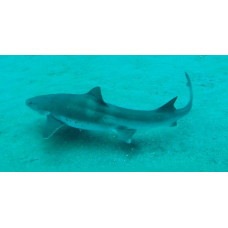Latin name
Triakis scyllium
Other name
Triakis scyllium
Identification
The banded houndshark has a short, broad, rounded snout and a slender body. The nostrils are wide apart and flanked by lobed flaps of skin that do not reach the mouth. The oval eyes are horizontally elongated and have a squint. There are protrusions below the eyes. The mouth forms a short, wide arch with long lip furrows at the corners. Each tooth has a dagger-shaped central point flanked by strong teeth. These sharks have 5 pairs of gill slits. The number of vertebrae varies from 149 to 155.
Features of fish fins
Nearly all fins are rather narrow. In adult sharks, the pectoral fins are broad and triangular. The caudal edges of the dorsal fins are nearly vertical. The base of the first dorsal fin lies between the bases of the pectoral and ventral fins. The second dorsal fin is slightly smaller than the first. Its base is above the base of the anal fin. The anal fin is considerably smaller than either dorsal fin. The caudal peduncle is short. The lower lobe of the caudal fin is short but well developed. There is a ventral notch at the tip of the upper caudal blade.
Fish colouring
The coloration of this species is gray with a pale belly. Juvenile sharks have dark saddle-shaped markings and spots scattered across their backs that fade with age.
Distribution
Widespread in the northwestern Pacific Ocean from the southern coast of the Far East (Russia) to Taiwan, including waters off Japan, Korea and eastern China. Records of these sharks off the Philippines are disputed.
Habitat
It is a common bottom-dwelling fish found on continental and island shelves, more often near shore, at depths down to 150 meters. Banded houndshark prefer sandy and algae-covered bottoms. They also tolerate brackish water and swim into estuaries and bays.
Size
The maximum recorded size of sharks of this species is 1.5 meters. The recorded life expectancy is 15 years for males and 18 years for females.
Behavior
The banded houndshark is nocturnal and usually solitary, although several individuals may rest together, sometimes piled on top of each other in a cave.
Food and feeding habits
Feeds primarily on crustaceans (including shrimp, crabs, hermit crabs, and mantis shrimp), cephalopods (including octopus), and spoonworms; polychaete worms, mussels, peanut worms, and small bony bottom fish (including flounder, sea eel, with occasional herring, jack, drum, and croaker). Shrimp and spoonworms are important prey for sharks up to 70 cm (28 inches) long. Cephalopod mollusks dominate the diet of larger sharks.
Reproduction
The banded houndshark mates in summer. During courtship, the male swims parallel to the female and grabs her pectoral fin with his teeth. After securing himself in this way, he wraps the back of his body around her and inserts a pterygopodium into her cloaca.
These sharks reproduce by live birth without a placenta, in which the embryo feeds exclusively on egg yolk. There are 9-26 newborns in a litter, although there are records of 42 sharks being born at the same time. Pregnancy lasts 9-12 months. Newborns range in length from 1-20 cm. Males and females reach sexual maturity at 5-6 years of age at 93-106 cm in length. Females mature at 6-7 years of age at 106-107 cm in length.
Fishing
It is not a targeted fishery. Banded houndshark are occasionally caught as by-catch in gillnets in Japanese waters. The meat is commercially available, but is considered to be of lower quality than other sharks in the region.
Relationship with a person
This species of shark is not dangerous to humans. They do well in captivity and are commonly kept in public aquariums in China and Japan. The International Union for Conservation of Nature has listed this species as endangered.
| Classification | |
| Phylum | Chordata |
| Class | Chondrichthyes |
| Squad | Carcharhiniformes |
| Family | Triakidae |
| Genus | Triakis |
| Species | T. scyllium |
| Features | |
| Conservation status | Endangered |
| Habitat | Bottom |
| Life span, years | 18 |
| Maximum body weight, kg | No information |
| Maximum length, cm | 150 |
| Sailing speed, m/s | No information |
| Threat to people | Edible |
| Way of eating | Predator |
Banded houndshark
Tags: banded houndshark


